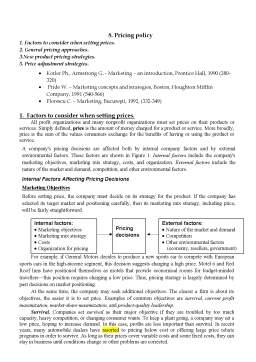Extras din curs
1. Factors to consider when setting prices.
All profit organizations and many nonprofit organizations must set prices on their products or services. Simply defined, price is the amount of money charged for a product or service. More broadly, price is the sum of the values consumers exchange for the benefits of having or using the product or service.
A company's pricing decisions are affected both by internal company factors and by external environmental factors. These factors are shown in Figure 1. Internal factors include the company's marketing objectives, marketing mix strategy, costs, and organization. External factors include the nature of the market and demand, competition, and other environmental factors.
Internal Factors Affecting Pricing Decisions
Marketing Objectives
Before setting price, the company must decide on its strategy for the product. If the company has selected its target market and positioning carefully, then its marketing mix strategy, including price, will be fairly straightforward.
For example, if General Motors decides to produce a new sports car to compete with European sports cars in the high-income segment, this decision suggests charging a high price. Motel 6 and Red Roof Inns have positioned themselves as motels that provide economical rooms for budget-minded travellers—this posi¬tion requires charging a low price. Thus, pricing strategy is largely determined by past decisions on market positioning.
At the same time, the company may seek additional objectives. The clearer a firm is about its objectives, the easier it is to set price. Examples of common objectives are survival, current profit maximization, market-share maximization, and product-quality leadership.
Survival. Companies set survival as their major objective if they are troubled by too much capacity, heavy competition, or changing consumer wants. To keep a plant going, a company may set a low price, hoping to increase demand. In this case, profits are less important than survival. In recent years, many automobile dealers have resorted to pricing below cost or offering large price rebate programs in order to survive. As long as their prices cover variable costs and some fixed costs, they can stay in business until conditions change or other problems are corrected.
Current Profit Maximization. Many companies want to set a price that will maximize current profits. They estimate what demand and costs will be at different prices and choose the price that will produce the maximum current profit, cash flow, or return on investment. In all cases, the company wants current financial outcomes rather than long-run performance.
Market-Share Leadership. Other companies want to obtain the dominant market share. They believe that the company with the largest market share will enjoy the lowest costs and highest long-run profit. To become the market-share leader, they set prices as low as possible. A variation of this objective is to pursue a specific market-share gain. Say the company wants to increase its market share from 10 percent to 15 percent in one year. It will search for the price and marketing program that will achieve this goal.
Product-Quality Leadership. A company might decide it wants to have the highest-quality product on the market. This normally calls for charging a high price to cover the cost of high product quality and the high cost of R&D. For example, the Sub-Zero Freezer Company seeks product-quality leadership, Sub-Zero makes the Rolls-Royce of refrigerators—custom-made, built-in units that look more like hardwood cabinets or pieces of furniture than refrigerators. By offering the highest quality, Sub-Zero sells over $50 million worth of fancy refrigerators a year, priced at up to $3,000 each.
Other Objectives - A company might also use price to attain other more specific objectives. It can set prices low to prevent competition from entering the market or set prices at competitors' levels to stabilize the market. Prices can be set to keep the loyalty and support of resellers or to avoid government intervention. Prices can be temporarily reduced to create excitement for a product or to draw more customers into a retail store. One product may be priced to help the sales of other products in the company's line. Thus, pricing may play an important role in helping to accomplish the company's objectives at many levels.
Marketing Mix Strategy
Price is only one of the marketing mix tools that the company uses to achieve its marketing objectives. Price decisions must be coordinated with product design, distribution, and promotion decisions to form a consistent and effective marketing program. Decisions made for other marketing mix variables may, affect pricing decisions. For example, producers who use many resellers who are expected to support and promote their products may have to build larger reseller margins into their prices. The decision to develop a high-quality position will mean that the seller must charge a higher price to cover higher costs.
The company often makes its pricing decision first and then bases other marketing mix decisions on the price it wants to charge. For example, Hyundai, Honda, and other makers of low-budget cars discovered a market segment for affordable cars and designed models to sell within the price range that this segment was willing to pay. Here, price was a key product-positioning factor that defined the product's market, competition, and design. The intended price determined what product features could be offered and what production costs could be incurred.
Thus, the marketer must consider the total marketing mix when setting prices. If the product is positioned on nonprice factors, then decisions about quality, promotion, and distribution will strongly affect price. If price is a key positioning factor, then price will strongly affect decisions on the other marketing mix elements. In most cases, the company will consider all the marketing mix decisions together when developing the marketing program.
Preview document
Conținut arhivă zip
- Pricing Policy.doc



























